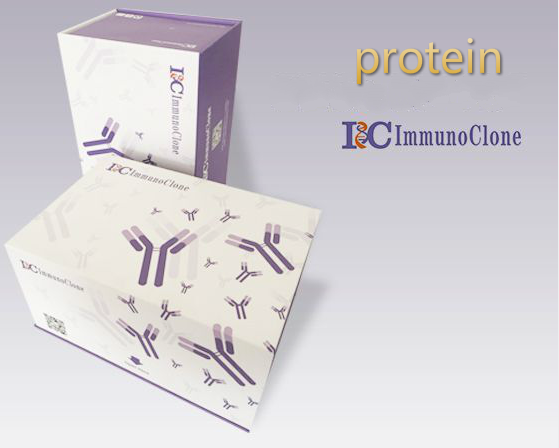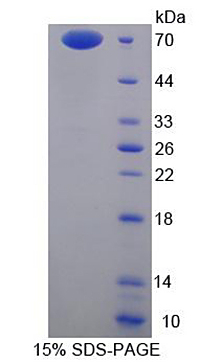

客服电话:021-61998208


膜联蛋白A9(ANXA9)重组蛋白
膜联蛋白A9(ANXA9)重组蛋白
Recombinant Annexin A9 (ANXA9)
ANX-A9; ANX31; Annexin-31; Pemphaxin
[ PROPERTIES ]
Residues: Met1~Met345
Tags: Two N-terminal Tags, His-tag and GST-tag
Accession: O76027
Host: E. coli
Subcellular Location: Cell surface, cytosol,
extracellular vesicular exosome.
Purity: >90%
Endotoxin Level: <1.0EU per 1μg
(determined by the LAL method).
Formulation: Supplied as lyophilized form in 20mM Tris,
150mM NaCl, pH8.0, containing 1mM EDTA, 1mM DTT,
0.01% sarcosyl, 5% trehalose, and preservative.
Predicted isoelectric point: 5.5
Predicted Molecular Mass: 68.4kDa
Applications: SDS-PAGE; WB; ELISA; IP.
(May be suitable for use in other assays to be determined by the end user.)
[ USAGE ]
Reconstitute in sterile ddH2O.
[ STORAGE AND STABILITY ]
Storage: Avoid repeated freeze/thaw cycles.
Store at 2-8
oC for one month.
Aliquot and store at -80oC for 12 months.
Stability Test: The thermal stability is described by the loss rate of the targetprotein. The loss rate was determined by accelerated thermal degradation test,that is, incubate the protein at 37oC for 48h, and no obvious degradation andprecipitation were observed. (Referring from China Biological Products Standard,which was calculated by the Arrhenius equation.) The loss of this protein is lessthan 5% within the expiration date under appropriate storage condition.
[ SEQUENCES ]
The sequence of the target protein is listed below.
MSVTGGKMAP SLTQEILSHL GLASKTAAWG TLGTLRTFLN FSVDKDAQRL LRAITGQGVDRSAIVDVLTN RSREQRQLIS RNFQERTQQD LMKSLQAALS GNLERIVMAL LQPTAQFDAQELRTALKASD SAVDVAIEIL ATRTPPQLQE CLAVYKHNFQ VEAVDDITSE TSGILQDLLLALAKGGRDSY SGIIDYNLAE QDVQALQRAE GPSREETWVP VFTQRNPEHL IRVFDQYQRSTGQELEEAVQ NRFHGDAQVA LLGLASVIKN TPLYFADKLH QALQETEPNY QVLIRILISRCETDLLSIRA EFRKKFGKSL YSSLQDAVKG DCQSALLALC RAEDM
[ REFERENCES ]
1. Morgan R.O., Fernandez M.-P. (1998) FEBS Lett. 434:300-304.
2. Nguyen V.T., et al. (2000) J. Biol. Chem. 275:29466-29476.
3. Bian Y., et al. (2014) J. Proteomics 96:253-262.
4. Goebeler V., et al. (2003) FEBS Lett. 546:359-364.
特别提示:本公司的所有产品仅可用于科研实验,严禁用于临床医疗及其他非科研用途!








